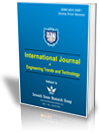The Global Rise of Robotics in Education: A Comprehensive Bibliometric Analysis
The Global Rise of Robotics in Education: A Comprehensive Bibliometric Analysis |
||
 |
 |
|
| © 2025 by IJETT Journal | ||
| Volume-73 Issue-3 |
||
| Year of Publication : 2025 | ||
| Author : Osman Diriye Hussein, Adam Muhudin, Abdullahi Mohamud Osoble, Mohamed Abdirahman Addow, Abdirahman Abdullahi Omar |
||
| DOI : 10.14445/22315381/IJETT-V73I3P119 | ||
How to Cite?
Osman Diriye Hussein, Adam Muhudin, Abdullahi Mohamud Osoble, Mohamed Abdirahman Addow, Abdirahman Abdullahi Omar, "The Global Rise of Robotics in Education: A Comprehensive Bibliometric Analysis," International Journal of Engineering Trends and Technology, vol. 73, no. 3, pp. 251-264, 2025. Crossref, https://doi.org/10.14445/22315381/IJETT-V73I3P119
Abstract
Using robotics in education has transformed teaching approaches and piqued student interest in a wide range of educational environments. This paper provides a comprehensive bibliometric examination of the field, tracing the evolution of robots in education from its inception to the present. The study indicates, based on a detailed investigation of multiple academic publications and sources, that research activity and publication trends have increased dramatically over the last 20 years. Key findings reveal that there has been a noticeable increase in publications and citations, particularly after 2019, demonstrating that robotics is becoming more widely acknowledged as a valuable teaching tool. Leading authors and nations who score particularly well are acknowledged as major contributors, with a focus on key publications and extensively cited sources that have changed the field. The report also delves into the key concepts and words driving current research, such as robotics curriculum integration, STEM education, and educational robotics. Thematic analyses demonstrate a shift in focus from general educational technologies to using robotics for targeted applications. This study not only traces the evolution of robotics in education but also highlights the crucial role of ongoing innovation in incorporating robots into educational systems and the potential for future research in this area.
Keywords
Educational robotics, STEM education, IoT in robotics, Student engagement, Bibliometric.
References
[1] Kaiqin Yang, Xin Liu, and Guang Chen, “Global Research Trends in Robot Education in 2009-2019: A Bibliometric Analysis,” International Journal of Information and Education Technology, vol. 10, no. 6, pp. 476-481, 2020.
[CrossRef] [Google Scholar] [Publisher Link]
[2] Natalia S. Aleksandrova et al., “Exploring the Frontiers: A Comprehensive Bibliometric Analysis of Robotics in Science Education,” Eurasia Journal of Mathematics, Science and Technology Education, vol. 20, no. 10, pp. 1-10, 2024.
[CrossRef] [Google Scholar] [Publisher Link]
[3] Min-Chi Chiu, Gwo-Jen Hwang, and Yun-Fang Tu, “Roles, Applications, and Research Designs of Robots in Science Education: A Systematic Review and Bibliometric Analysis of Journal Publications from 1996 To 2020,” Interactive Learning Environments, vol. 32, no. 5, pp. 1834-1859, 2024.
[CrossRef] [Google Scholar] [Publisher Link]
[4] Zehui Zhan et al., “A Bibliometric Analysis of the Global Landscape on STEM Education (2004-2021): Towards Global Distribution, Subject Integration, and Research Trends,” Asia Pacific Journal of Innovation and Entrepreneurship, vol. 16, no. 2, pp. 171-203, 2022.
[CrossRef] [Google Scholar] [Publisher Link]
[5] Mario A. Rojas-Sánchez, Pedro R. Palos-Sánchez, and José A. Folgado-Fernández, “Systematic Literature Review and Bibliometric Analysis on Virtual Reality and Education,” Education and Information Technologies, vol. 28, no. 1, pp. 155-192, 2022.
[CrossRef] [Google Scholar] [Publisher Link]
[6] Xiali Xue et al., “Global Trends and Hotspots in Research on Rehabilitation Robots: A Bibliometric Analysis from 2010 To 2020,” Frontiers in Public Health, vol. 9, pp. 1-17, 2022.
[CrossRef] [Google Scholar] [Publisher Link]
[7] Guanjun Bao et al., “Soft Robotics: Academic Insights and Perspectives through Bibliometric Analysis,” Soft Robotics, vol. 5, no. 3, pp. 229-241, 2018.
[CrossRef] [Google Scholar] [Publisher Link]
[8] Rashmi Yogesh Pai et al., “Effectiveness of Social Robots as A Tutoring and Learning Companion: A Bibliometric Analysis,” Cogent Business & Management, vol. 11, no. 1, pp. 1-17, 2024.
[CrossRef] [Google Scholar] [Publisher Link]
[9] A. Musbahi, C.B. Rao, and A. Immanuel, “A Bibliometric Analysis of Robotic Surgery from 2001 to 2021,” World Journal of Surgery, vol. 46, no. 6, pp. 1314-1324, 2022.
[CrossRef] [Google Scholar] [Publisher Link]
[10] Siwei Chen et al., “Simulation-Based Training in Robotic Surgery Education: Bibliometric Analysis and Visualization,” Journal of Robotic Surgery, vol. 18, no. 1, 2024.
[CrossRef] [Google Scholar] [Publisher Link]
[11] Cristian Mejia, and Yuya Kajikawa, “Bibliometric Analysis of Social Robotics Research: Identifying Research Trends and Knowledgebase,” Applied Sciences, vol. 7, no. 12, pp. 1-17, 2017.
[CrossRef] [Google Scholar] [Publisher Link]
[12] Heather Carter-Templeton et al., “Robotics in Nursing: A Bibliometric Analysis,” Journal of Nursing Scholarship, vol. 50, no. 6, pp. 582-589, 2018.
[CrossRef] [Google Scholar] [Publisher Link]
[13] Na Zhang et al., “Social Robots Supporting Children’s Learning and Development: Bibliometric and Visual Analysis,” Education and Information Technologies, vol. 29, no. 10, pp. 12115-12142, 2024.
[CrossRef] [Google Scholar] [Publisher Link]
[14] Cheng Li et al., “Clinical Application of Robotic Orthopedic Surgery: A Bibliometric Study,” BMC Musculoskeletal Disorders, vol. 22, no. 1, pp. 1-14, 2021.
[CrossRef] [Google Scholar] [Publisher Link]
[15] Timothy Boulos, Farid Sartipi, and Khoshaba Khoshaba, “Bibliometric Analysis on the Status Quo of Robotics in Construction,” Journal of Construction Materials, vol. 1, no. 2, pp. 1-9, 2020.
[Google Scholar]
[16] Giorgia Atzeni et al., “A Bibliometric Analysis on Collaborative Robots in Logistics 4.0 Environments,” Procedia Computer Science, vol. 180, pp. 686-695, 2021.
[CrossRef] [Google Scholar] [Publisher Link]
[17] Jianmin Wang et al., “Research Hotspots and Trends of Social Robot Interaction Design: A Bibliometric Analysis,” Sensors, vol. 23, no. 23, pp. 1-20, 2023.
[CrossRef] [Google Scholar] [Publisher Link]
[18] Ekene Francis Okagbue et al., “An In-Depth Analysis of Humanoid Robotics in Higher Education System,” Education and Information Technologies, vol. 29, no. 1, pp. 185-217, 2023.
[CrossRef] [Google Scholar] [Publisher Link]
[19] Jesús López-Belmonte et al., “Robotics in Education: A Scientific Mapping of the Literature in Web of Science,” Electronics, vol. 10, no. 3, pp. 1-18, 2021.
[CrossRef] [Google Scholar] [Publisher Link]
[20] T. Pachidis et al., “Social Robotics in Education: State-of-the-Art and Directions,” Advances in Service and Industrial Robotics: Proceedings of the 27th International Conference on Robotics in Alpe-Adria Danube Region, pp. 689-700, 2019.
[CrossRef] [Google Scholar] [Publisher Link]

